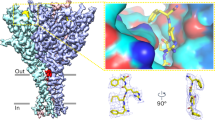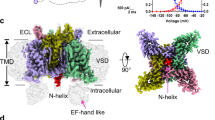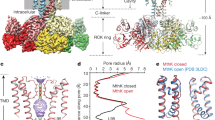Abstract
VOLTAGE-DEPENDENT ion channels are the basis of nerve impulse propagation along the axon. The mechanism of gating and ionic selectivity of these channels remains obscure as long as the membrane molecules participating in these processes are unknown. Some biochemical properties of a tetrodotoxin binding component of the sodium channel have been determined1, but for the potassium channel not even the number of channels per unit axon surface is known. From noise measurements it has been estimated that the squid giant axon contains about 60 K+ channels μm−2 (ref. 2), but this figure remains to be confirmed by other methods. Here I report experiments showing that specific and covalent labelling of tetraethylammonium (TEA) binding sites with a radioactive photoaffinity label can be achieved. 4-Azido-2-nitrobenzyltriethylammonium fluoroborate has been shown to block selectively, and after irradiation irreversibly, potassium conductance in the node of Ranvier of frog sciatic nerve3. I present here evidence that in crayfish unmyelinated nerve fibres, the label used reacts with a hydrophobic area at the mouth of the potassium channel postulated by Armstrong4.
This is a preview of subscription content, access via your institution
Access options
Subscribe to this journal
Receive 51 print issues and online access
$199.00 per year
only $3.90 per issue
Buy this article
- Purchase on Springer Link
- Instant access to full article PDF
Prices may be subject to local taxes which are calculated during checkout
Similar content being viewed by others
References
Benzer, T., & Raftery, M. A. Proc. natn. Acad. Sci. U.S.A. 69, 3634 (1972).
Conti, F., DeFelice, L. J. & Wanke, E. J. Physiol., Land. 248, 45 (1975).
Hucho, F., Bergman, C., Dubois, J. M., Rojas, E. & Kiefer, H. Nature 260, 802 (1976).
Armstrong, C. M. J. gen. Physiol. 58, 413 (1971).
Davies, G. E. & Stark, G. R. Proc. natn. Acad. Sci. U.S.A. 66, 651–656 (1970).
Hucho, F., Layer, P., Kiefer, H. & Bandini, G. Proc. natn. Acad. Sci. U.S.A. 73, 2624 (1976).
Duguid, J. R. & Raftery, M. A. Biochemistry 12, 3593 (1973).
Author information
Authors and Affiliations
Rights and permissions
About this article
Cite this article
HUCHO, F. TEA binding sites in crayfish axon membranes. Nature 267, 719–720 (1977). https://doi.org/10.1038/267719a0
Received:
Accepted:
Published:
Issue Date:
DOI: https://doi.org/10.1038/267719a0
This article is cited by
-
Biochemical investigations of ionic channels in excitable membranes
Molecular and Cellular Biochemistry (1977)
Comments
By submitting a comment you agree to abide by our Terms and Community Guidelines. If you find something abusive or that does not comply with our terms or guidelines please flag it as inappropriate.



